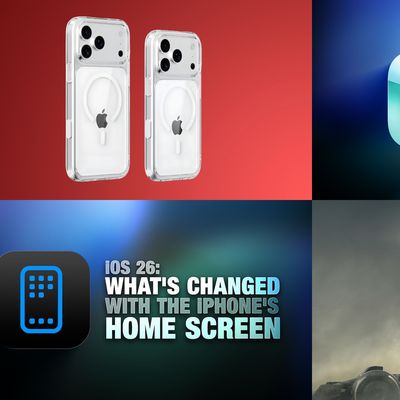Adobe Introduces 'Muse' Subscription-Based Website Creation Tools
 Adobe today announced the launch of a beta version of new website-building tools codenamed "Muse" that will allow users to easily create websites without needing to know HTML. Being compared in some ways as an advanced version of Apple's phased-out iWeb software, Muse is targeted at print designers with little or no experience in web design.
Adobe today announced the launch of a beta version of new website-building tools codenamed "Muse" that will allow users to easily create websites without needing to know HTML. Being compared in some ways as an advanced version of Apple's phased-out iWeb software, Muse is targeted at print designers with little or no experience in web design.
Plan your project — Easy-to-use sitemaps, master pages, and a host of flexible, site-wide tools make it fast and intuitive to get your site planned out and ready for design.
Design your pages — Combine imagery, graphics and text with complete control, flexibility and power (almost as if you were using Adobe InDesign).
Add interactivity — Drag and drop fully customizable widgets like navigation menus and slide shows, embed HTML code snippets to include things like Google Maps, enable tool tips, rollovers and much more.
Publish your site — Preview your site with Muse to see how it looks and test how it works. Then convert to a live website using Adobe for hosting, or export the HTML for hosting with a provider of your choice.
Adobe Muse offers users familiar with such products as Illustrator, InDesign, and Dreamweaver an easy transition to HTML-free web design, with customizable drag-and-drop widgets being complemented by embeddable code from sites like Google Maps and Facebook to extend the functionality.
As
Macworld notes, users will not be required to use Adobe's hosting service for projects created in Muse, but the company is planning to introduce new features such as blogs, contact forms, and shopping carts that would require users to utilize Adobe hosting if they wish to take advantage of the features.
Muse is currently in a free public beta phase, with the official version set to launch early next year. Muse will be a subscription-based product, with pricing set at $20 per month or $180 per year. Adobe notes that it intends to roll out new features for Muse on a regular basis ("probably quarterly"), making a subscription model a better option than Adobe's traditional system of standalone purchases of major versions released every 18-24 months.
Popular Stories
A new Apple TV is expected to be released later this year, and a handful of new features and changes have been rumored for the device.
Below, we recap what to expect from the next Apple TV, according to rumors.
Rumors
Faster Wi-Fi Support
The next Apple TV will be equipped with Apple's own combined Wi-Fi and Bluetooth chip, according to Bloomberg's Mark Gurman. He said the chip supports ...
Apple will launch its new iPhone 17 series in two months, and the iPhone 17 Pro models are expected to get a new design for the rear casing and the camera area. But more significant changes to the lineup are not expected until next year, when the iPhone 18 models arrive.
If you're thinking of trading in your iPhone for this year's latest, consider the following features rumored to be coming...
Apple's next-generation iPhone 17 Pro and iPhone 17 Pro Max are only two months away, and there are plenty of rumors about the devices.
Below, we recap key changes rumored for the iPhone 17 Pro models.
Latest Rumors
These rumors surfaced in June and July:A redesigned Dynamic Island: It has been rumored that all iPhone 17 models will have a redesigned Dynamic Island interface — it might ...
The long wait for an Apple Watch Ultra 3 is nearly over, and a handful of new features and changes have been rumored for the device.
Below, we recap what to expect from the Apple Watch Ultra 3:Satellite connectivity for sending and receiving text messages when Wi-Fi and cellular coverage is unavailable
5G support, up from LTE on the Apple Watch Ultra 2
Likely a wide-angle OLED display that ...
iPhone 17 Pro and iPhone 17 Pro Max models with displays made by BOE will be sold exclusively in China, according to a new report.
Last week, it emerged that Chinese display manufacturer BOE was aggressively ramping up its OLED production capacity for future iPhone models as part of a plan to recapture a major role in Apple's supply chain.
Now, tech news aggregator Jukan Choi reports...
The iOS 26 public beta release is quickly approaching, while developers have recently gotten their hands on a third round of betas that has seen Apple continue to tweak features, design, and functionality.
We're also continuing to hear rumors about the iPhone 17 lineup that is now just about right around the corner, while Apple's latest big-budget film appears to be taking off, so read on...
![]() Adobe today announced the launch of a beta version of new website-building tools codenamed "Muse" that will allow users to easily create websites without needing to know HTML. Being compared in some ways as an advanced version of Apple's phased-out iWeb software, Muse is targeted at print designers with little or no experience in web design.
Adobe today announced the launch of a beta version of new website-building tools codenamed "Muse" that will allow users to easily create websites without needing to know HTML. Being compared in some ways as an advanced version of Apple's phased-out iWeb software, Muse is targeted at print designers with little or no experience in web design.

















